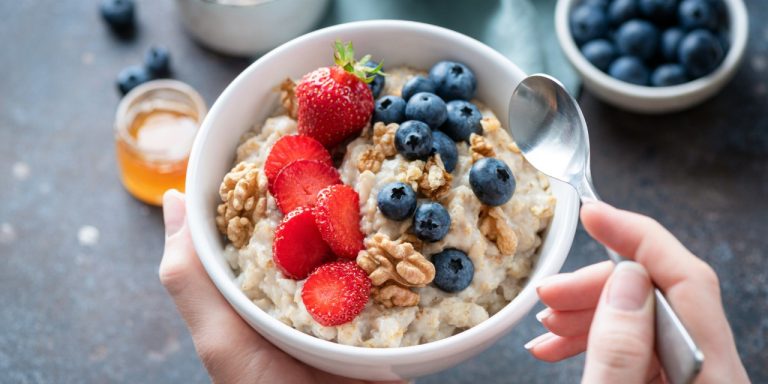
Fibre: effect, daily requirements and food
What are the benefits of fibre and how much fibre should you be getting every day? Which foods contain large amounts of fibre? Find out more about dietary fibre and a high-fibre diet.
What is fibre?
Fibre (also referred to as dietary fibre and plant fibre) is a constituent part of certain plant-based foods. It performs various tasks within the body – such as during digestion. for example. Fibre also influences the colour and shape of stools. The microbiome in the gut benefits from fibre too, as it increases the variety of good intestinal bacteria. Dietary fibres consist primarily of long-chain polysaccharides. These are a specific type of carbohydrates. Experts differentiate between soluble and insoluble fibres.
Soluble fibre
Combined with water, soluble fibres (e.g. inulin, pectin and resistant starch) form a gelatinous substance. As a result, soluble fibre impacts the texture and size of our stool, making it softer and larger. This in turn facilitates regular emptying of the bowel. This makes fibre an effective remedy against constipation. It also provides nourishment for the intestinal bacteria. The bacteria in the large intestine break down this type of dietary fibre and multiply when you get enough of it.
Insoluble fibre
Insoluble fibres (e.g. lignin and cellulose) bind water, which causes them to swell significantly. This increases the size of the stool – making it pass through the intestine faster. In doing so, insoluble fibres aid regular digestion. This type of dietary fibre is barely broken down by our intestinal bacteria.
Fibre – other tasks in the body
Fibre has an effect on our gut, and therefore our digestion. And it has a host of other favourable effects on the body too:
- Fibre reduces cholesterol in the body. It binds bile acid in the digestive tract. The body excretes this more quickly and forms it again. For this it needs cholesterol, reducing our cholesterol level.
- Fibre also influences blood pressure. Intestinal bacteria produce a specific fatty acid from dietary fibre called propionic acid. This stabilises blood pressure.
- Fibre also has a positive effect on blood sugar levels. It reduces the risk of type 2 diabetes.
- Fibre can also aid weight loss, because it helps keep you full for longer.
- Plant fibre reduces the risk of cardiovascular diseases. That’s because it keeps you fuller for longer and, under certain circumstances, can help to reduce excess weight. It also lowers blood sugar and cholesterol levels. This has a positive effect on the cardiovascular system.
- Fibre promotes intestinal activity and helps us to excrete potentially harmful substances. This reduces the likelihood of developing colon cancer.
How much fibre should I eat per day?
Daily fibre requirements vary depending on age. Roughly 30 grams per day are recommended for healthy adults, and a little less for children and adolescents. Opt for a balanced diet with plenty of fruit and vegetables as well as wholegrain products to ensure you take on board sufficient dietary fibres. For instance, five portions of fruit and vegetables, one portion of wholegrains (e.g. wholemeal pasta, quinoa, brown rice), three slices of wholemeal bread and two to three medium-sized potatoes are adequate.
Note that women should ideally get 30 grams of fibre a day while pregnant and breastfeeding.
Which foods contain a lot of fibre?
Fibre-rich foods are part of a balanced diet. But which foods are high in fibre? Dietary fibres are contained almost exclusively in plant-based foods – primarily in fruit and vegetables, wholegrains, pulses and nuts. Animal-based food products, on the other hand, contain almost zero fibre.
Foods which are particularly high in fibre include:
- Fruit, especially avocados, apples, pears, plums and apricots
- Berries such as blackberries and raspberries
- Vegetables such as sprouts, kale, broccoli, artichoke, celeriac and sweet potatoes
- Wholegrains, including oats, quinoa, couscous and brown rice, as well as products made from wholegrain (e.g. oat flakes, bread and pasta)
- Pulses like beans, chickpeas, lentils
- Nuts, kernels and seeds, like flaxseeds, chia seeds, sunflower and pumpkin seeds, almonds, walnuts and pistachios
- Bran and psyllium husks
Note that there are many more foods that contain fibre. This is not an exhaustive list. The table below gives you a few ideas about how you can meet your daily dietary fibre requirements (quantities per person):
|
|
|
|
|
|
|
|
|
|
|
|
|
|
|
Breakfast
- Muesli with oat flakes, berries and fruit as well as flaxseed or seeds (10 g of fibre) or
- Two 50 g slices of wholemeal bread (8 g of fibre) with two tablespoons of peanut butter (unsweetened, 2 g of fibre)
Snack
- One 125 g apple (2.5 g of fibre)
Lunch
- A large portion of vegetables – e.g. 150 g each of broccoli and peppers – (10 g of fibre), plus 120 g of wholemeal pasta (uncooked, 6 g of fibre) or
- A large 150 g portion of salad with seeds (2 g of fibre), half an avocado (7 g of fibre, plus a 50 g slice of wholemeal bread (4 g of fibre) with two tablespoons of hummus (2 g of fibre)
Snack
- A handful (roughly 30 g) of unsalted nuts (3 g of fibre)
Dinner
- Curry, including 150 g of sweet potatoes (4.5 g of fibre) and ½ tin of chickpeas (drained, 5 g of fibre), plus 60 g of brown rice (uncooked, 2 g of fibre) or
- A 60 g portion of wholemeal couscous (uncooked, (5 g of fibre) with ½ tin of chickpeas (drained, 5 g of fibre) and 150 g of broccoli (4 g of fibre)
If you have too much fibre at once, you may experience some of the following symptoms:
- Bloating
- Feeling of fullness
- Gastro-intestinal pain
You can prevent this by gradually increasing the amount of high-fibre food you consume. This will give your body enough time to get used to it.
It’s important that you consult a doctor if your symptoms do not improve, or you start to experience additional symptoms like nausea or vomiting. There may be another reason for this.
Tips for a high-fibre diet
These tips can help you on your way towards a diet with lots of high-fibre foods:
- Plan meals in advance and shop accordingly. This will allow you to ensure that you have all the food you need in the house.
- Swap sweets for fruit and vegetables. This will help you boost your dietary fibre intake.
- Always opt for the wholemeal version of bread, pasta, rice, etc.
- Avoid processed foods. Opt instead for natural and fresh foods if you want to eat more fibre.
- Want to eat more fibre? Increase your intake gradually. Drink enough water too, ideally around 2.5 litres per day. This will allow the fibre to take optimal effect.
Try to get your child used to high-fibre foods as early as possible. For instance, you could combine white and brown pasta or white and brown rice. This will help your child’s digestion to gradually adapt to dietary fibres. If your child refuses brown rice, parboiled rice is a good alternative. It contains key nutrients, even though it is white. At the bakery, ask specifically for bread or rolls with high wholemeal content.
Dietary fibres can enrich your diet in a variety of ways. For instance, they aid digestion and stabilise blood glucose levels. Getting enough fibre also boosts your fitness and well-being. Consciously incorporate fibre-rich foods into your daily routine so you can benefit from its positive effects in the long term.

The specialist provided the editorial team with advice and input for this article. Tanja Micheli, registered nurse and IKP nutrition expert (Institute for Body-Centred Psychotherapy) works in the Helsana Health Consultation Service. She helps customers on issues to do with nutrition and health promotion.


Newsletter
Find out more about current health issues every month and get all the information you need about our attractive offers from all Helsana Group companies * delivered by e-mail to read whenever it suits you. Our newsletter is free of charge and you can sign up here:
We did not receive your information. Please try again later.
* The Helsana Group comprises Helsana Insurance Company Ltd, Helsana Supplementary Insurances Ltd and Helsana Accidents Ltd.